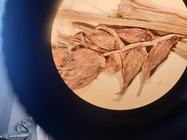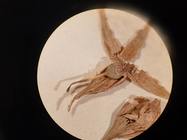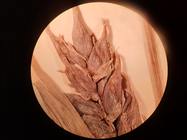Cyperaceae taxon details
Carex idzuroei Franch. & Sav.
1676462 (urn:lsid:marinespecies.org:taxname:1676462)
accepted
Species
Carex pseudovesicaria H.Lév. & Vaniot · unaccepted
terrestrial
Franchet, A. & Savatier, L. (1878). Enumeratio plantarum : in Japonia sponte crescentium hucusque rite cognitarum, adjectis descriptionibus specierum pro regione novarum, quibus accedit determinatio herbarum in libris japonicis. 2., available online at https://www.biodiversitylibrary.org/page/6210685#page/3/mode/1up
page(s): 583 [details]
page(s): 583 [details]
Taxonomic remark Diffère du C. bullata, auquel il ressemble beaucoup, par ses périgynes bruns, plus grands, à nervures bien plus...
Taxonomic remark Diffère du C. bullata, auquel il ressemble beaucoup, par ses périgynes bruns, plus grands, à nervures bien plus nombreuses et disposées à des intervalles égaux; par son bec lisse, membraneux, par ses écailles femelles scabres sur le dos; l'achaine est irisé et comme métallique, particularité qui s'observe chez d'autres espèces, notamment chez le C. utriculata Boott. Cette irisation parait se produire sur une membrane extrêmement mince qui enveloppe étroitement l'achaine. Cette membrane est assez distincte chez l'Isolepis micheliana et sur les achaines de plusieurs Cyperus. Nous ne savons trop si ces reflets métalliques constituent un caractère constant. [details]
Cyperaceae Working Group. (2025). [see How to cite]. Global Cyperaceae Database. Carex idzuroei Franch. & Sav.. Accessed at: https://cyperaceae.org/aphia.php?p=taxdetails&id=1676462 on 2025-09-12
Date
action
by
2024-12-10 11:47:54Z
unchecked
db_admin
![]() The webpage text is licensed under a Creative Commons
Attribution 4.0 License
The webpage text is licensed under a Creative Commons
Attribution 4.0 License
Nomenclature
original description
Franchet, A. & Savatier, L. (1878). Enumeratio plantarum : in Japonia sponte crescentium hucusque rite cognitarum, adjectis descriptionibus specierum pro regione novarum, quibus accedit determinatio herbarum in libris japonicis. 2., available online at https://www.biodiversitylibrary.org/page/6210685#page/3/mode/1up
page(s): 583 [details]
original description (of Carex pseudovesicaria H.Lév. & Vaniot) Léveillé, H.; Vaniot, E. (1902). Carex du Japon. <em>Bulletin de l'Académie internationale de géographie botanique.</em> ser 3, 11(152): 175-187., available online at https://www.biodiversitylibrary.org/page/4531818
page(s): 180 [details]
basis of record Plants of the World Online (POWO). , available online at https://powo.science.kew.org/ [details]
page(s): 583 [details]
original description (of Carex pseudovesicaria H.Lév. & Vaniot) Léveillé, H.; Vaniot, E. (1902). Carex du Japon. <em>Bulletin de l'Académie internationale de géographie botanique.</em> ser 3, 11(152): 175-187., available online at https://www.biodiversitylibrary.org/page/4531818
page(s): 180 [details]
basis of record Plants of the World Online (POWO). , available online at https://powo.science.kew.org/ [details]
Other
additional source
Li, B. Z.; Zhang, S. R. (2024). An updated species checklist and taxonomic synopsis of Cyperaceae in China. <em>Biodiversity Science.</em> 32(7): 24106., available online at https://doi.org/10.17520/biods.2024106 [details] Available for editors  [request]
[request]
 Present
Present  Inaccurate
Inaccurate  Introduced: alien
Introduced: alien  Containing type locality
Containing type locality
Syntype P 00284126, geounit Japan [details]
From editor or global species database
Diagnosis Læte virens, rigidula; culmi ultra pedales, graciles, leves ad medium usque foliati; folia culmos superantia, marginibus subtilissime serrulata scabra, transversim striolata, longe vaginata, vaginis ore antico oblique sectis, ligula interiori oblongâ; bracteæ foliaceæ, inferior culmo longior, evaginata vel brevissime vaginans; spiculæ masculæ 2, inferior duplo brevior, sessilis, superior subbipollicaris, linearis, squamis anguste lanceolatis, pallide stramineis, valide uninerviis, nunc subobtusis, nunc acutis, longe acuminatis, marginibus anguste albo hyalinis, mox fimbriato laceris; spiculæ femineæ 3, subdensifloræ, cylindraceæ, 2-4 cent. longæ, 15 mill. latæ, suprema arcte sessilis e masculis longe distans, inferior breviter (1 cent.) pedunculata, erecta, squamis ovato lanceolatis perigynio triplo brevioribus et multo angustioribus, lateribus sordide albis, hyalinis, dorso viridibus, subtrinerviis, nervo medio scabro in acumen serrulatum (præsertim in squamis inferioribus) producto; perigynium 10-12 mill. longum, stipitatum, fusco olivaceum (haud omnino maturum), 24-30 nervium, e basi ovatâ in rostrum longum attenuatum, rostro ore membranaceo, albo, levi, bifido; achænium laxe inclusum, perigynio 4plo brevius, late ovatum, trigonum, lineatim punctatum, iricolori metallicum, apice truncatum; stylus rectus, basi æqualis. [details]Taxonomic remark Diffère du C. bullata, auquel il ressemble beaucoup, par ses périgynes bruns, plus grands, à nervures bien plus nombreuses et disposées à des intervalles égaux; par son bec lisse, membraneux, par ses écailles femelles scabres sur le dos; l'achaine est irisé et comme métallique, particularité qui s'observe chez d'autres espèces, notamment chez le C. utriculata Boott. Cette irisation parait se produire sur une membrane extrêmement mince qui enveloppe étroitement l'achaine. Cette membrane est assez distincte chez l'Isolepis micheliana et sur les achaines de plusieurs Cyperus. Nous ne savons trop si ces reflets métalliques constituent un caractère constant. [details]
Translation Bright green, stiff; culms more than a foot long, slender, with a few leaves up to the middle portion; leaves longer than the culms, with margins very subtly serrated and rough, with transverse cross-septa, sheaths long, edge of the sheath oriented toward the apex obliquely cut, inside ligule oblong ; bracts foliaceous, the lowest one longer than the culm, sheathless or with a very short sheath; male spikes 2, lower two times shorter than the upper one, sessile, upper less than 2 inches long, linear, scales narrowly lanceolate, pale stramineous, strongly 1-nerved, subobtuse, acute or long acuminate, with white narrow hyaline margins, soon becoming fimbriate; female spikelets 3, subdensely floriferous, cylindrical, 2-4 cm long, 15 mm wide, the upper ones contiguous, sessile, far distant from the males, the lower one shortly (1 cm) pedunculate, erect; pistillate scales ovate-lanceolate, 1/3 the length of the associated perigynia and much narrower, margins dirty white and hyaline, center greenish, with up to three veins, middle vein scabrous, ending in a serrulate acumen (especially in the lower scales); perigynia 10-12 mm long, stipitate, olive-brown (not entirely mature), 24-30 veins, starting from the ovate base and ending into the prolonged long-tapered beak, beak with membranous white margins, smooth, bifid; achene loosely enclosed, 4 times shorter than the associated perigynia, broadly ovate, triangular, with papillae arranged in lines, iridescent metallic, apex truncate; style straight, base equal. [details]
Translation It differs from C. bullata, which it closely resembles, in having larger brown perigynia with many more veins arranged at equal intervals, a smooth, membranous beak and female scales scabrous on the back. The achene is iridescent and metallic, a feature observed in other species, notably C. utriculata Boott. This iridescence appears to occur on an extremely thin membrane that tightly envelops the achene. This membrane is quite distinct in Isolepis micheliana and on the achenes of several Cyperus species. We are not sure whether this metallic sheen is a constant feature. [details]
| Language | Name | |
|---|---|---|
| Japanese | ウマスゲ | [details] |
Photos of Cyperaceae by Hoshino Labo. from Japan
To Biodiversity Heritage Library (1 publication) (from synonym Carex pseudovesicaria H.Lév. & Vaniot)
To Biodiversity Heritage Library (6 publications)
To International Plant Names Index (IPNI) (from synonym Carex pseudovesicaria H.Lév. & Vaniot)
To International Plant Names Index (IPNI)
To Plants of the World Online
To Plants of the World Online (from synonym Carex pseudovesicaria H.Lév. & Vaniot)
To Biodiversity Heritage Library (1 publication) (from synonym Carex pseudovesicaria H.Lév. & Vaniot)
To Biodiversity Heritage Library (6 publications)
To International Plant Names Index (IPNI) (from synonym Carex pseudovesicaria H.Lév. & Vaniot)
To International Plant Names Index (IPNI)
To Plants of the World Online
To Plants of the World Online (from synonym Carex pseudovesicaria H.Lév. & Vaniot)
From editor or global species database






